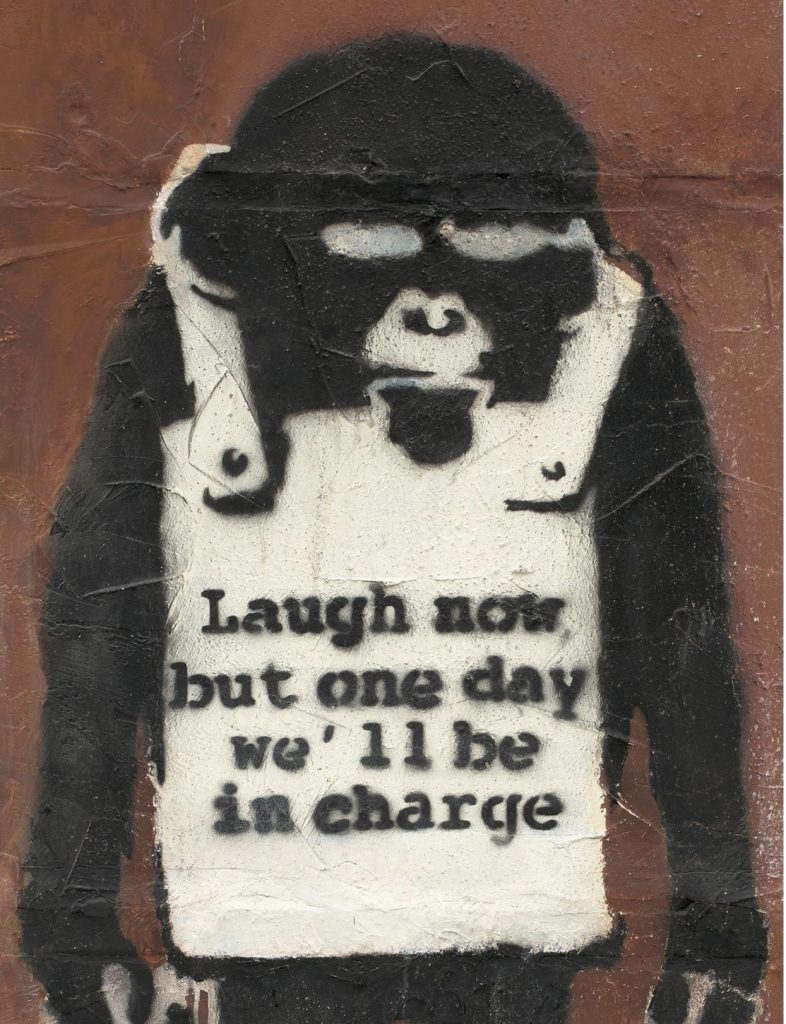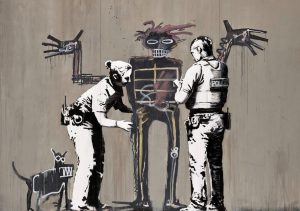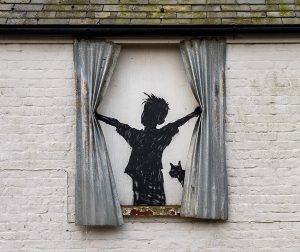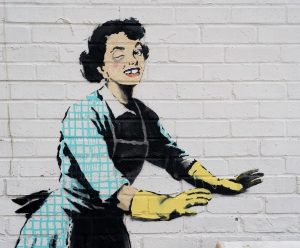Phillips Hong-Kong: 5 June 2021
HKD 24,450,000
Exhibited
Existencilism, 33 1/3 Gallery, Los Angeles, 2002
Banksy: War, Capitalism & Liberty, Palazzo Cipolla, Rome, 2016


This is important, as since its inception, this motif of the monkey with his placard has since become one of Banksy’s most iconic, cherished, and instantly recognizable images. The composition has been recreated by the artist himself repeatedly in the years to follow, but also replicated and imitated countless times, with a simple Google search of ‘Banksy – Laugh Now’ producing over 660,000 image results. Indisputably, Banksy’s Laugh Now motif has helped to cement his position as a key figure in the art historical canon, and when the original work from Ocean Rooms l sold at auction in 2008, it broke the record for the artist at that time.
“You paint 100 chimpanzees and they still call you a guerrilla artist.”
The present work is thus rare, not only because it was also created in the year 2002, making it one of Banksy’s first Laugh Now creations, but also because this specific iteration – Laugh Now Panel A– boasts the historical significance of having been unveiled at the artist’s first Los Angeles show (and fourth ever solo show in a formal exhibition space), which was hosted at 33 1/3 Gallery between 19 July – 18 August 2002. Titled Existencilism, the exhibition debuted works including Queen Victoria and Love is in the air, which along with his Laugh Now chimps, are now considered icons of our times.
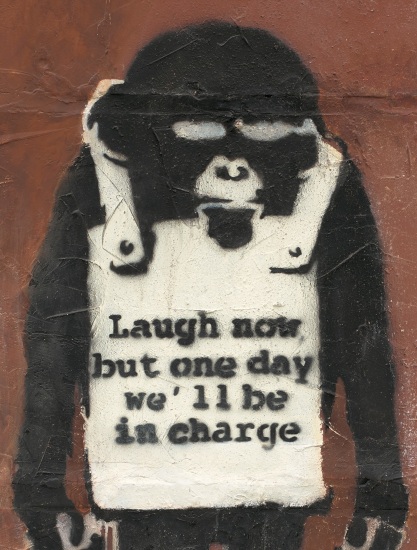
Laugh Now Panel A also comprised part of the major exhibition War, Capitalism & Liberty at the prestigious Palazzo Cipolla Museum in Rome, which ran between 24 May – 4 September 2016. Visited by thousands, the museum show was highly praised as a thought-provoking display of his most well-known pieces, providing an insightful survey into Banksy’s contextual exploration into the globally prevalent issues the exhibition title lays out.
Like much of Banksy’s work, Laugh Now Panel A is ambiguous in nature yet carries discernible subversive undertones. Monkeys and humans have historically shared a close relationship, as expounded in Charles Darwin’s mid-1800s publication, Theory of Evolution. Darwin’s book asserted that humans evolved from apes and thus although humans may have set out to create distance between our relatives by ridiculing them as savages – as popularized by French artists in the 18th century in a visual arts genre called singerie, whereby monkeys are depicted in comical scenes aping human behavior – rather, so often we see humans acting in ways that cannot be considered as ‘above’ the animal kingdom.

Antoine Watteau, The Monkey Sculptor, circa 1710
Collection of Musée des Beaux-Arts d’Orléans
In contemporary popular culture, this is famously explored in the internationally iconic franchise, Planet of the Apes, a trilogy of science-fiction classics set on a futuristic planet where apes rule and humans are slaves. In their clash for control, complex sociological themes are explored, reflecting tensions relating to humanity and power that are also probed in Banksy’s satiric work.
 Still from Planet of the Apes, 1963
Still from Planet of the Apes, 1963
By using the form of a solitary chimpanzee, who seems powerless, slumped with dejected eyes with their mouth set in a grim line, the viewer immediately feels sympathy for this creature, enticed to help the chimp out of its predicament. Whilst similar motifs arise in his oeuvre, this iteration of Banksy’s is a rare, unique rendering, spray painted in black and white onto the rusting-red surface of a drywall. This distinctiveness is heighted due to the dripping paint that cascades down in the lower half of the composition, with the element of chance thus making the stenciled painting a one of a kind. Indeed, this dripping effect only appears sporadically throughout Banksy’s overall series of Laugh Now works, contributing even more so to this work’s uniqueness. Falling from the chimp’s hands and feet, the white trails of paint recalls the image of heavy chains weighing the chimp down, working in tandem with the board strapped to his body.
Hunched over the weight of their placard, the composition strikes a sense of despondency that many in the workforce have felt, quipping at ideas of social unrest. But through the text ‘Laugh now but one day we’ll be in charge’, Banksy disrupts the somber scene with his dark humor, and feelings of sadness for the chimp are replaced with the prospect that these symbols of the downtrodden will rise to become the figures in charge. Although not referring to a specific group or situation, Laugh Now Panel A allows the viewer to interpret the image how they please, and relate it to personal or general issues faced in contemporary society. As such, rendered in a clean aesthetic that is instantly digestible with a graphic bang, Banksy succeeds in giving form to a poignant message with maximum force.
